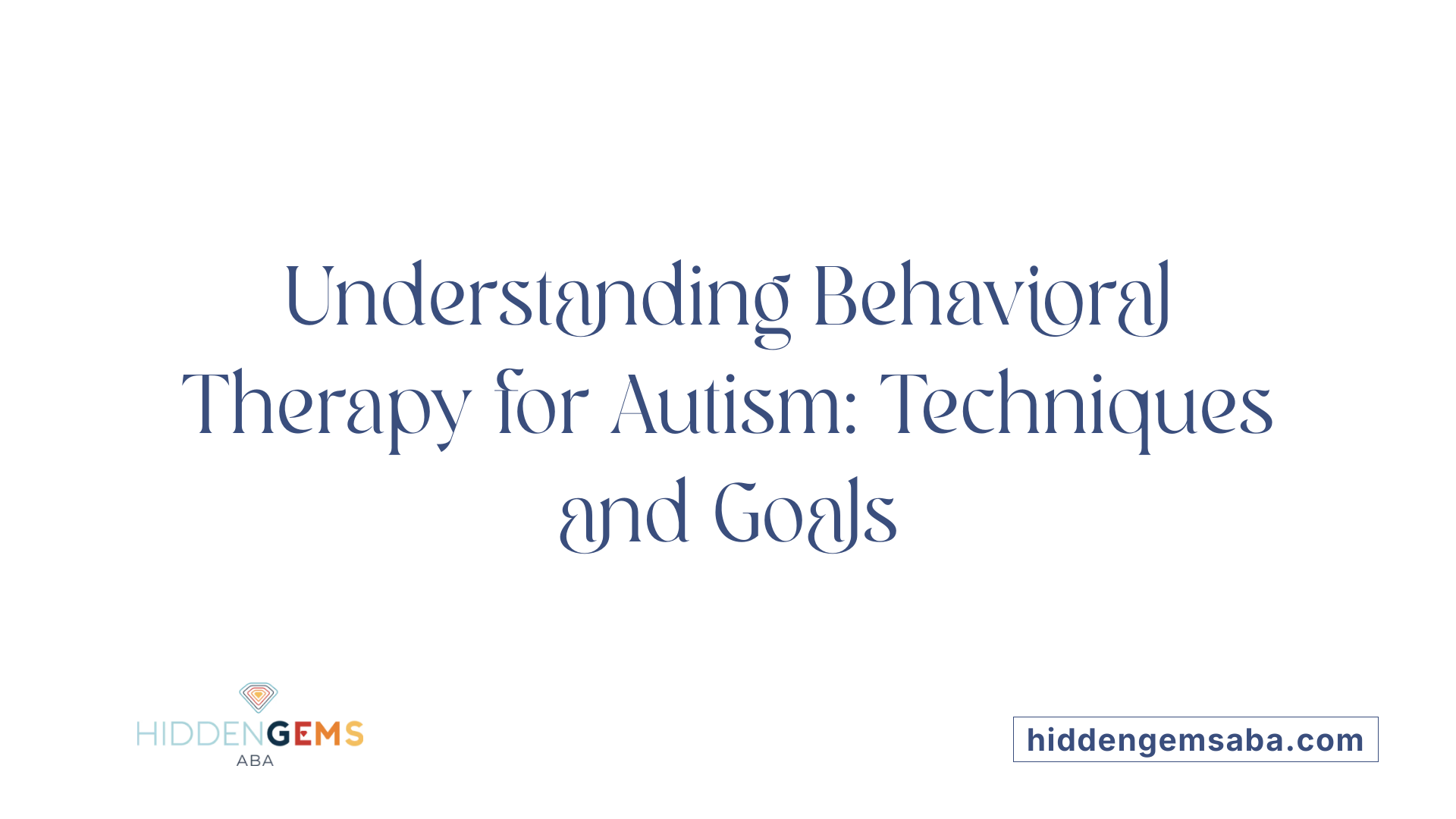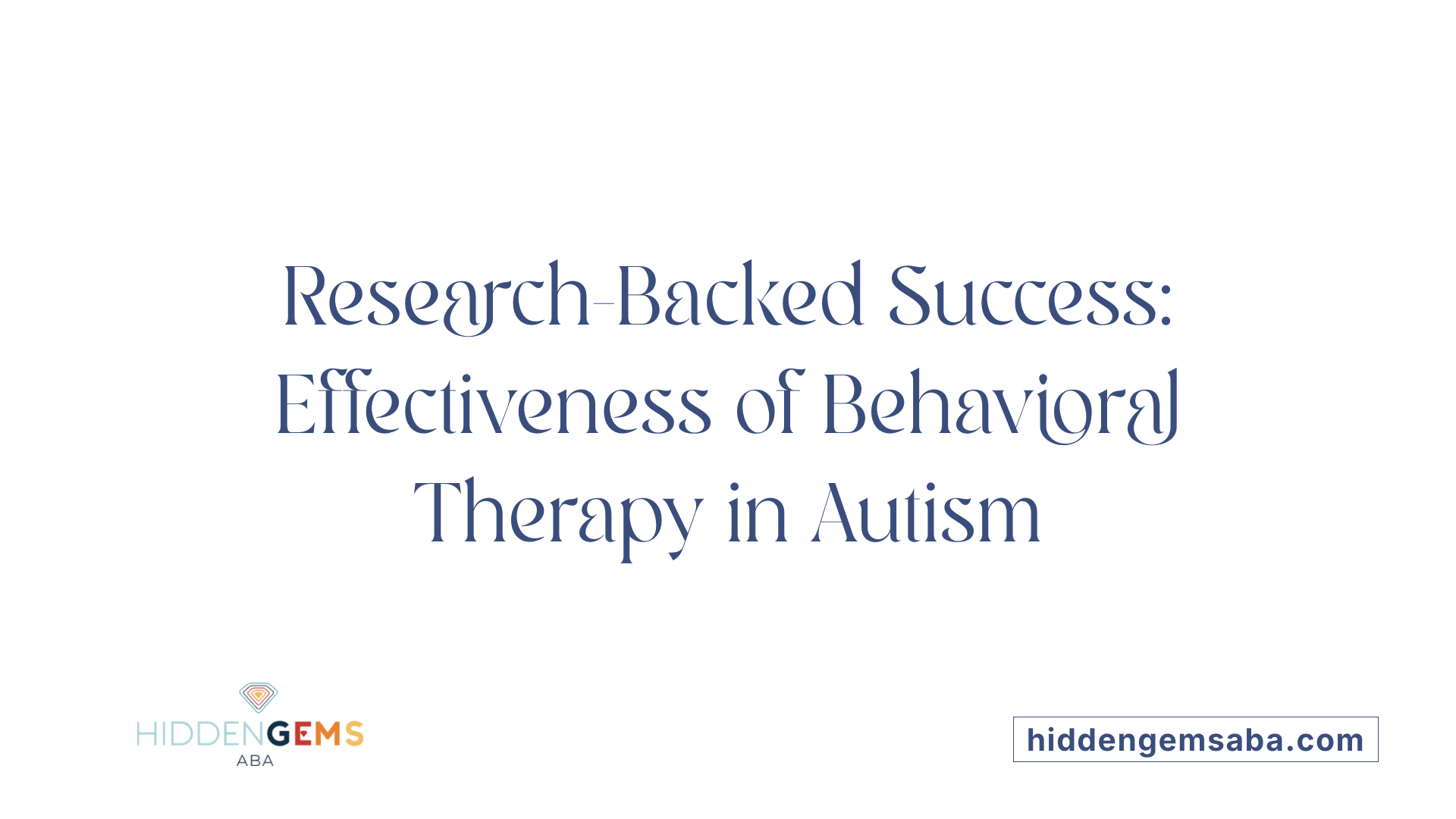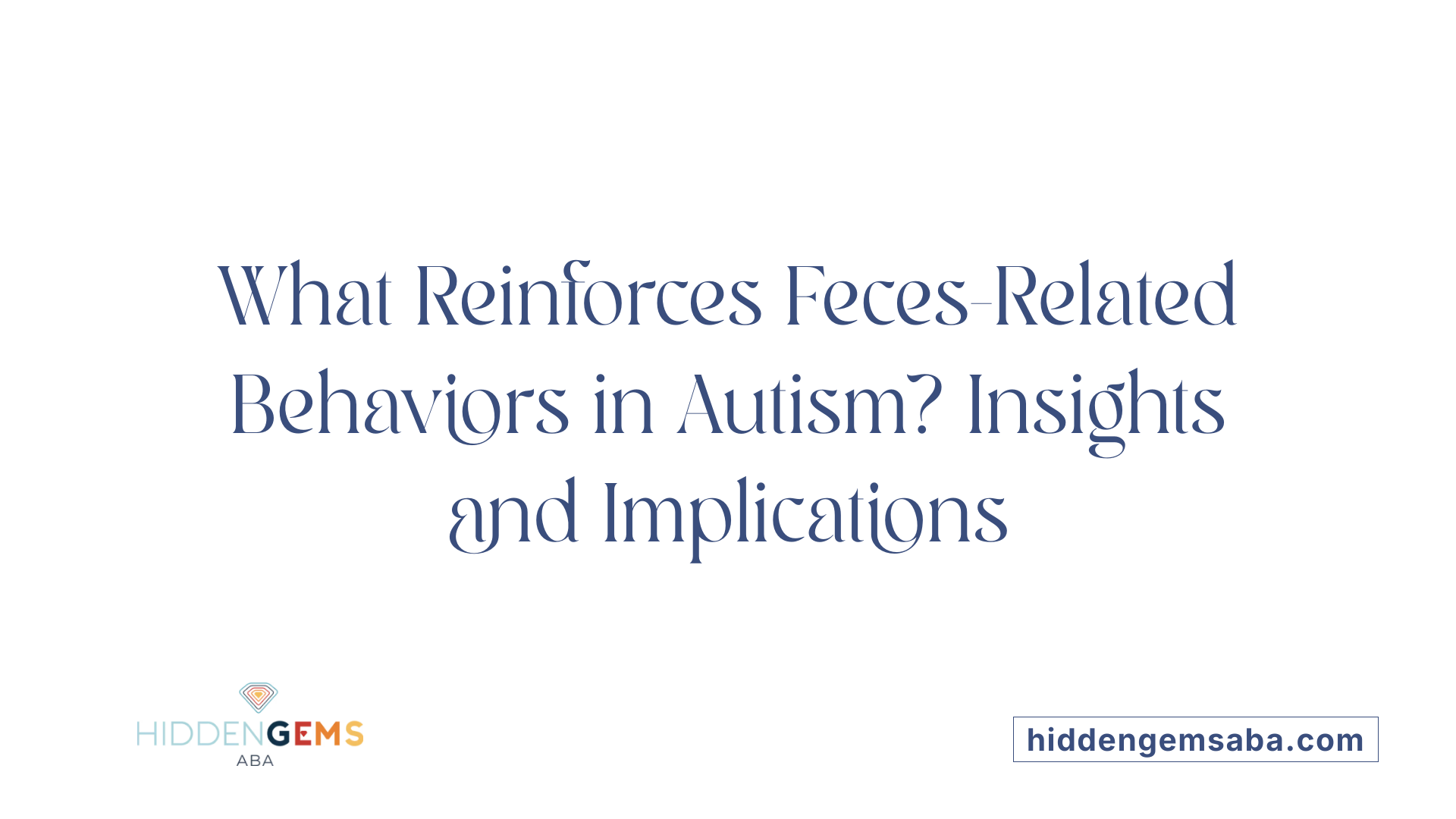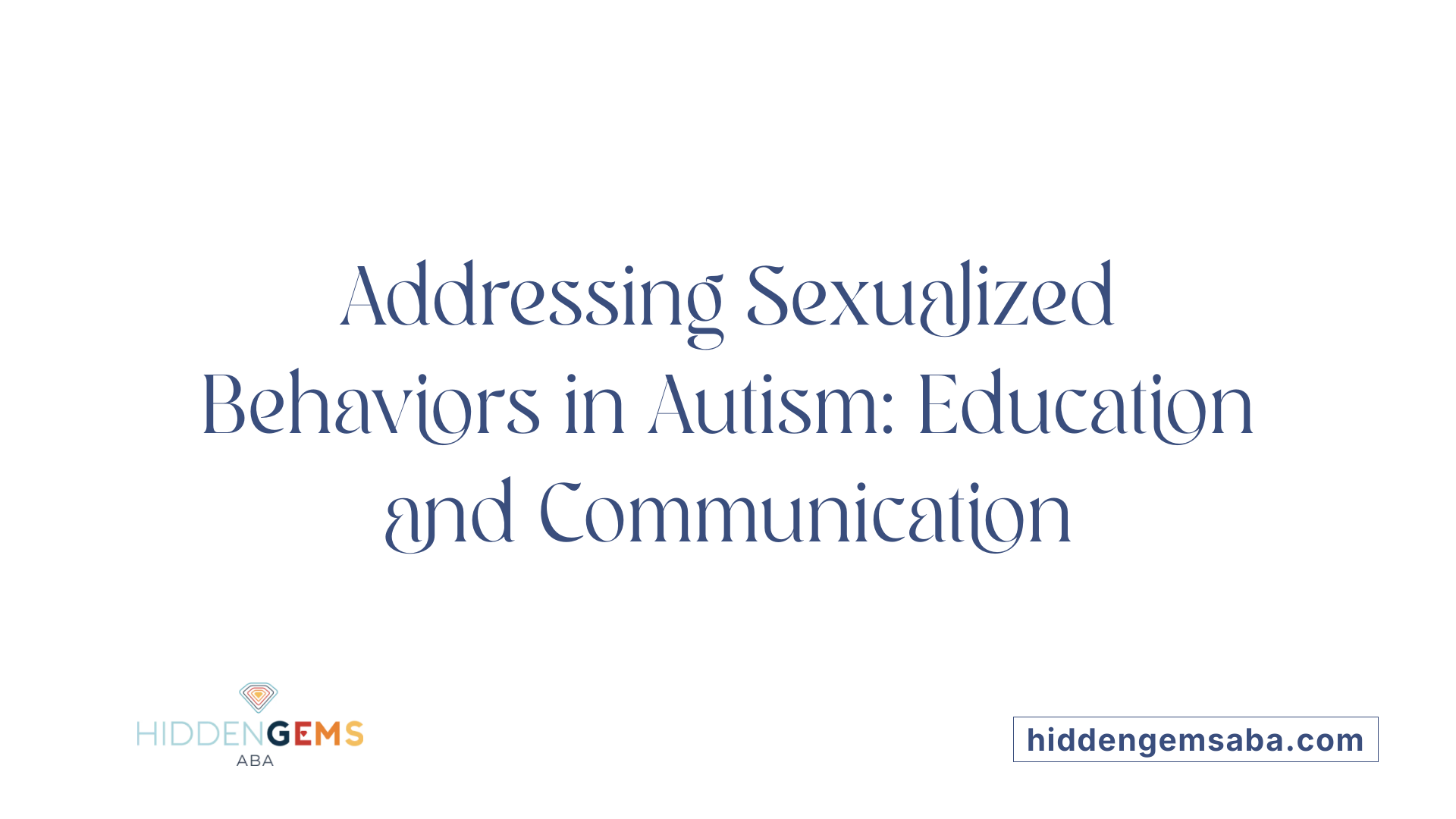Exploring the Complex Issue of Fecal Smearing in Autism
Fecal smearing is a challenging and often distressing behavior observed in some individuals with Autism Spectrum Disorder (ASD). This behavior requires careful assessment and intervention grounded in behavioral science and medical understanding. This article delves into the causes, assessment tools, therapeutic approaches, and emerging treatments relevant to fecal smearing in autism, alongside related behaviors and gastrointestinal issues common in this population.
What Is Behavioral Therapy for Autism?

What is behavioral therapy for autism?
Behavioral therapy for autism is a structured approach designed to improve specific behaviors, such as communication, social skills, and daily living abilities. This therapy is largely based on applied behavior analysis (ABA), which uses positive reinforcement and carefully designed interventions to encourage helpful behaviors and reduce problematic ones. It is highly individualized to meet the unique needs of each person with autism and often involves trained behavior analysts working in settings like homes, schools, or communities.
Goals of behavioral therapy
The primary goals are to enhance skills that facilitate independence and social interaction while minimizing behaviors that may be harmful or interfere with learning. For example, therapy targets reducing challenging behaviors such as fecal smearing, pica, and inappropriate social behaviors by identifying the reasons behind these actions and applying appropriate interventions.
Methods used in behavioral therapy
Behavioral therapy employs various techniques informed by assessments like the Functional Assessment Interview (FAI) and Functional Assessment Screening Tool (FAST). Functional Behavioral Assessment (FBA) helps determine why certain maladaptive behaviors occur—for instance, whether they serve to gain attention, provide sensory stimulation, or allow escape from demands. Based on these insights, customized interventions are implemented, including:
- Sensory and tactile kits
- Differential Reinforcement of Other behavior (DRO)
- Planned ignoring to reduce attention to unwanted behaviors
- Social stories that teach appropriate social responses
- Token economies which use rewards to motivate behavior change
- Verbal redirection techniques
- Sexuality education tailored to individual needs
These targeted strategies have proven effective in decreasing the frequency of challenging behaviors when designed in harmony with a clear understanding of their functions. Behavioral therapy thus plays an essential role in supporting individuals with autism to lead more fulfilling, adaptive lives.
How Applied Behavior Analysis (ABA) Facilitates Autism Therapy

How does applied behavior analysis (ABA) work in autism therapy?
Applied Behavior Analysis (ABA) works by carefully analyzing behaviors through understanding their triggers (antecedents), the behaviors themselves, and their outcomes (consequences). This approach uses positive reinforcement to encourage desirable behaviors, helping individuals with autism learn new skills and reduce unwanted or harmful behaviors. ABA programs focus on breaking down complex skills like communication, social interaction, self-care, and academics into manageable parts and teaching them systematically.
What techniques are used in ABA?
ABA employs a variety of evidence-based techniques tailored to the individual’s needs. Some common methods include:
- Positive Reinforcement: Rewarding good behaviors to encourage their repetition.
- Differential Reinforcement: Reinforcing alternative or other appropriate behaviors to reduce problematic ones.
- Planned Ignoring: Deliberately not responding to minor problematic behaviors to decrease their occurrence.
- Social Stories: Using narratives to teach social cues and appropriate responses.
- Token Economies: Reinforcing desired behaviors through token-based rewards that can be exchanged for preferred items or activities.
- Verbal Redirection: Prompting more appropriate behaviors through verbal cues.
How are ABA programs individualized and supervised?
ABA programs are customized through Functional Behavioral Assessments (FBAs) to identify the reasons behind challenging behaviors. Tools like the Functional Assessment Interview (FAI) and Functional Assessment Screening Tool (FAST) help clinicians and caregivers understand why behaviors occur, such as seeking attention or sensory stimulation. Based on these insights, specific interventions are designed and closely monitored by trained professionals, such as behavior analysts, to ensure effectiveness. This individualized and supervised approach is crucial for achieving meaningful behavior change and skill development in individuals with autism.
Professionals Delivering Behavioral Therapy for Autism

Who provides behavioral therapy services for individuals with autism?
Behavioral therapy services for individuals with autism are primarily delivered by specialists trained in Applied Behavior Analysis (ABA). The core providers include Board Certified Behavior Analysts (BCBAs) who are responsible for developing and overseeing individualized behavior plans tailored to each person's needs.
Alongside BCBAs, behavior technicians and therapists carry out the detailed implementation of these plans. These practitioners use evidence-based approaches like functional behavioral assessments (FBA) to identify triggers for maladaptive behaviors and design targeted interventions such as differential reinforcement, token economies, or social stories.
Types of providers
- Board Certified Behavior Analysts (BCBAs): Experts who assess, design, and supervise ABA interventions.
- Behavior Technicians: Trained staff who provide direct, hands-on therapy under BCBA supervision.
- Speech therapists and occupational therapists: Often collaborate to address communication and sensory needs.
Training and certifications
Professionals typically hold specialized certifications, such as the BCBA credential, which requires graduate-level education, supervised experience, and passing a certification exam. Behavior technicians often complete training programs and must be supervised by a BCBA.
Service delivery settings
Behavioral therapy can be provided in various settings to maximize accessibility and effectiveness:
- Clinical centers: Structured environments for intensive therapy.
- Home-based services: Personalized to integrate interventions within the individual's daily life.
- Schools: Collaborative programs supporting academic and social development.
These providers and settings ensure delivery of scientifically founded, individualized interventions to improve communication, social skills, and reduce challenging behaviors among individuals with autism.
Common Goals of Behavioral Therapy in Autism Treatment

What are the common goals of behavioral therapy in autism treatment?
Behavioral therapy for autism spectrum disorder (ASD) primarily focuses on enhancing skills and reducing behaviors that challenge daily functioning.
The main objectives include improving communication skills and language development, enabling individuals to express their needs and interact more effectively. Enhancing social interaction is another crucial goal, helping individuals develop better relationships and respond appropriately in social situations.
Another important aim is increasing daily living skills, such as self-care and independence, to promote autonomy. Finally, behavioral therapy targets the reduction of problematic behaviors that interfere with learning and social engagement, including behaviors such as fecal smearing, pica, and other maladaptive actions.
These goals are typically met through individualized behavior modification plans guided by Functional Behavioral Assessments (FBAs). Techniques often used include differential reinforcement, token economies, verbal redirection, and social stories. Early intervention is emphasized to maximize progress.
Overall, behavioral therapy in autism strives to equip individuals with practical skills that improve their quality of life and help them participate more fully in their communities.
Evidence Supporting the Effectiveness of Behavioral Therapy for Autism

What evidence supports the effectiveness of behavioral therapy for autism?
Behavioral therapy plays a crucial role in supporting individuals with autism spectrum disorder (ASD), addressing core symptoms and challenging behaviors. Research highlights various behavioral interventions that effectively improve language, social communication, and adaptive functioning.
Types of Behavioral Therapies
Prominent behavioral therapies include Applied Behavior Analysis (ABA), Picture Exchange Communication System (PECS), Discrete Trial Training (DTT), Pivotal Response Treatment (PRT), Treatment and Education of Autistic and Communication-Handicapped Children (TEACCH), and Early Intensive Behavioral Intervention (EIBI). These approaches are tailored to individual needs and focus on reinforcing positive behaviors while reducing maladaptive ones.
Research Findings
Studies demonstrate that these therapies enhance language development, social skills, and adaptive behaviors. Specifically, interventions targeting behaviors such as fecal smearing, pica, and sexualized behaviors—common in some individuals with ASD—show significant improvement when rooted in functional behavioral assessments (FBAs). FBAs identify behavioral functions, allowing customized behavior modification plans that employ techniques like differential reinforcement, token economies, social stories, and verbal redirection.
Meta-Analyses Results
Meta-analytical reviews of randomized controlled trials reveal moderate effect sizes for Cognitive Behavioral Therapy (CBT) in enhancing social skills and decreasing anxiety among children and adolescents with ASD. Evidence supports that early and consistent intervention yields better outcomes. Moreover, combining therapies, such as integrating DTT with TEACCH, can amplify improvements in linguistic abilities, personal autonomy, and social engagement.
Combined Approaches
Integrating multiple behavioral strategies caters to the complex needs of individuals with ASD. For example, programs combining sensory integration kits with reinforcement techniques address sensory sensitivities alongside behavioral concerns. This holistic approach ensures comprehensive care that aligns with each individual's unique behavioral functions and developmental profile.
While the effectiveness of behavioral therapies is well-supported, ongoing research is essential to optimize intervention strategies and tailor treatments further. This will enhance outcomes for individuals with ASD across diverse settings.
| Therapy Type | Primary Focus | Research Outcome |
|---|---|---|
| Applied Behavior Analysis (ABA) | Behavior modification | Improves communication, reduces maladaptive behaviors |
| Discrete Trial Training (DTT) | Structured learning sessions | Enhances language and social skills |
| Cognitive Behavioral Therapy (CBT) | Anxiety and social skills | Moderate improvements in social functioning and anxiety |
| TEACCH | Visual and structured teaching | Supports personal autonomy and daily living skills |
| Functional Behavioral Assessment (FBA) | Identifying behavioral functions | Enables targeted interventions for challenging behaviors |
Understanding Fecal Smearing in Autism: Behavioral Perspectives

What is Fecal Smearing?
Fecal smearing is a challenging behavior commonly observed in some individuals with Autism Spectrum Disorder (ASD). It involves the intentional spreading or smearing of feces on surfaces, objects, or oneself. This behavior can be distressing for caregivers and presents unique challenges in care and management.
How Common is Fecal Smearing in ASD?
While not all individuals with ASD exhibit fecal smearing, it is one of several maladaptive behaviors identified in this population. Its frequency varies but is significant enough to warrant specialized assessment and intervention strategies tailored to affected individuals.
What Behavioral Functions Maintain Fecal Smearing?
Research utilizing Functional Behavioral Assessments (FBA) has found that fecal smearing behaviors are often maintained by several functions:
- Attention Seeking: The individual may receive increased attention from caregivers when engaging in this behavior.
- Sensory Stimulation: The tactile and sensory experiences associated with fecal smearing can be inherently reinforcing.
- Escape or Avoidance: Engaging in fecal smearing may help an individual avoid or escape unpleasant tasks or demands.
By identifying these maintaining factors using tools such as the Functional Assessment Interview (FAI) and Functional Assessment Screening Tool (FAST), clinicians and caregivers can develop individualized behavior modification programs. These tailored interventions have been shown to effectively reduce the occurrence of fecal smearing by addressing its specific behavioral functions.
Understanding fecal smearing through a behavioral lens emphasizes the importance of comprehensive assessment and targeted interventions that consider the individual needs and motivations behind the behavior.
Functional Behavioral Assessment (FBA): Identifying Causes of Challenging Behaviors

What is the Purpose and Process of Functional Behavioral Assessment (FBA)?
Functional Behavioral Assessment (FBA) is a systematic process used to identify the specific factors that maintain maladaptive behaviors in individuals with Autism Spectrum Disorder (ASD). Its main goal is to understand why challenging behaviors—such as fecal smearing, pica, anal poking, and sexualized behaviors—occur, by uncovering their underlying functions. This assessment helps clinicians and caregivers tailor individualized behavior modification programs that effectively decrease the frequency of these behaviors.
What Tools Are Used in Functional Behavioral Assessment?
Two commonly used tools in FBA include the Functional Assessment Interview (FAI) and the Functional Assessment Screening Tool (FAST). The FAI involves structured interviews with those familiar with the individual's behavior, gathering detailed information about the context and consequences of behaviors. Meanwhile, the FAST serves as a questionnaire to quickly identify potential causes or maintaining factors of behaviors.
These tools aid in pinpointing whether certain behaviors are maintained by factors such as attention, sensory stimulation, or escape from demands. Understanding these functions is crucial for directing appropriate interventions.
How Is FBA Applied Specifically in Cases of Fecal Smearing?
Behaviors related to feces, like fecal smearing, often present complex challenges. FBA helps discern if such behaviors are driven by desires for attention, sensory needs, or to avoid certain situations. Once these motives are identified, specific behavioral interventions—such as sensory/tactile kits to address sensory needs, differential reinforcement of other behavior (DRO), or social stories—can be implemented. For instance, targeted programs informed by FBA have shown success in reducing fecal smearing by addressing the root causes effectively.
In summary, FBA plays a vital role in clarifying the reasons behind challenging behaviors in individuals with ASD. Utilizing tools like FAI and FAST enables customized strategies that support behavior reduction and improve overall quality of life.
Maintaining Variables of Feces-Related Behaviors in Autism

What Role Does Attention Seeking Play in Feces-Related Behaviors?
Feces-related behaviors, such as fecal smearing, in individuals with autism spectrum disorder (ASD) are often influenced by the function of gaining attention. When a person exhibits such behaviors, caregivers and others may respond with increased interaction, which can unintentionally reinforce the behavior by providing social attention. Recognizing this dynamic is critical for designing interventions that minimize reinforcement of undesirable behaviors.
How Does Sensory Stimulation Influence These Behaviors?
Sensory stimulation is another significant factor maintaining feces-related behaviors in ASD. For some individuals, the tactile and sensory experience derived from these behaviors satisfies a sensory need or preference. This sensory aspect can be a powerful motivator, making the behavior self-reinforcing. Effective intervention needs to address these sensory components by possibly substituting alternative sensory activities or providing sensory/tactile kits.
Why Does Escape from Demands Affect Feces-Related Behaviors?
Escape or avoidance of demands is a further variable contributing to these behaviors. Individuals may engage in feces-related actions to avoid unpleasant tasks or social situations. This escape function means the behavior acts as a coping mechanism to reduce stress or demands placed by the environment or caregivers.
What Are the Implications for Intervention?
Understanding whether attention, sensory stimulation, or escape maintains feces-related behaviors guides tailored intervention strategies. Functional Behavioral Assessment (FBA) tools, such as the Functional Assessment Interview (FAI) and Functional Assessment Screening Tool (FAST), help clinicians and caregivers identify these maintaining variables accurately. Based on assessment results, interventions like differential reinforcement of other behavior (DRO), planned ignoring, social stories, and sensory/tactile kits can be implemented effectively, leading to reductions in these challenging behaviors.
This individualized approach ensures that interventions are focused on modifying the underlying cause rather than just the surface behavior, promoting more sustainable behavior change.
Individualized Behavior Modification Strategies to Address Fecal Smearing and Related Behaviors

What behaviors are targeted?
In individuals with Autism Spectrum Disorder (ASD), challenging behaviors such as fecal smearing, pica (ingestion of non-food items), anal poking, and sexualized behaviors often require targeted intervention. These behaviors can cause significant distress and health risks, necessitating careful assessment and treatment.
How are behavior modification plans developed?
Functional Behavioral Assessment (FBA) is a valuable tool used to identify the specific variables maintaining these maladaptive behaviors. Through tools like the Functional Assessment Interview (FAI) and Functional Assessment Screening Tool (FAST), clinicians and caregivers gather information to understand whether behaviors are maintained by attention, sensory stimulation, or escape. This understanding helps to tailor individualized behavior modification programs that address the underlying reasons.
What interventions are used?
Behavioral interventions designed from FBA results include:
- Sensory/Tactile Kits: Providing appropriate sensory input to fulfill sensory needs that may drive behaviors.
- Differential Reinforcement of Other Behavior (DRO): Reinforcing all behaviors except the problematic ones to reduce their occurrence.
- Planned Ignoring: Deliberately withholding attention when behaviors seek it as a reward.
- Social Stories: Teaching appropriate behaviors and social cues through narrative aids.
- Token Economies: Using a system of rewards for exhibiting desired behaviors.
- Verbal Redirection: Guiding the individual’s attention away from the problem behavior towards more appropriate activities.
- Sexuality Education: Addressing sexualized behaviors through age-appropriate education.
What outcomes have been observed?
Applying these individualized programs has been effective in reducing the frequency of fecal smearing, pica, anal poking, and sexualized behaviors. By focusing on the function of behaviors identified through functional assessments, interventions become more precise and effective, improving both safety and quality of life for individuals with ASD.
Behavioral Interventions Employed for Managing Fecal Smearing

What behavioral interventions are used to manage fecal smearing in individuals with ASD?
Managing fecal smearing and related behaviors in individuals with Autism Spectrum Disorder (ASD) requires targeted behavioral interventions. Several strategies have been employed effectively, guided by insights gained from Functional Behavioral Assessments (FBA).
Sensory/Tactile Kits
Sensory or tactile kits are designed to address the sensory needs of individuals who engage in fecal smearing. These kits include various textured items that provide alternative sensory stimulation, helping to reduce the need for the behavior.
Differential Reinforcement of Other Behavior (DRO)
DRO involves reinforcing the individual when they abstain from the problematic behavior for specific intervals. This technique encourages the development of more appropriate behaviors by withholding reinforcement for fecal smearing.
Planned Ignoring
Planned ignoring is used for behaviors maintained by attention. By deliberately withholding attention following fecal smearing, the behavior’s reinforcement diminishes over time.
Social Stories
Social stories explain appropriate behaviors and social cues in a narrative format tailored to the individual's comprehension level. They help individuals understand the boundaries and expectations regarding hygiene-related behaviors.
Token Economies
Token economies provide tokens as rewards for desired behaviors, which can later be exchanged for preferred items or activities. This system motivates the individual to engage in acceptable behaviors instead of fecal smearing.
Verbal Redirection
Verbal redirection involves guiding the individual’s attention away from the unwanted behavior and towards a positive activity or response, helping to interrupt the behavior cycle.
Sexuality Education
Sexuality education is an essential intervention component, especially to address sexualized behaviors linked to fecal smearing. It promotes understanding of appropriate and inappropriate behavior in a developmentally sensitive manner.
These behavior modification techniques, based on careful functional assessment, enable clinicians and caregivers to customize interventions effectively. By addressing the underlying motivations such as sensory seeking or attention, these approaches have led to documented reductions in the frequency of fecal smearing among individuals with ASD.
Role of Sensory Processing in Fecal Smearing Behavior

How does sensory stimulation maintain fecal smearing behavior?
Fecal smearing behavior in individuals with autism spectrum disorder (ASD) is often maintained, in part, by sensory stimulation. The repetitive action provides tactile feedback that meets certain sensory needs or preferences, reinforcing the behavior. Understanding that sensory input plays a critical role allows caregivers and therapists to address the root cause rather than just the symptom.
How can sensory/tactile kits be used to address this behavior?
Sensory or tactile kits consist of various materials designed to provide appropriate sensory feedback. These kits can be introduced as part of behavioral interventions to satisfy the individual's sensory needs in safer, more acceptable ways. For example, items with different textures or pressure sensations help replace fecal smearing by offering alternative sources of tactile stimulation.
What is the relationship between sensory needs and maladaptive behaviors?
Maladaptive behaviors like fecal smearing often serve as coping mechanisms for sensory processing difficulties in ASD. When individuals have unmet sensory needs, they may engage in behaviors that provide comfort or regulation. By correctly identifying and fulfilling these sensory requirements, interventions can reduce the occurrence of such behaviors. This approach is supported by functional behavioral assessment findings that highlight the importance of sensory stimulation as a maintaining factor.
In summary, addressing sensory processing challenges through targeted interventions such as sensory/tactile kits can effectively reduce fecal smearing by offering alternative ways to meet sensory demands. This approach promotes better behavior management tailored to the individual's specific sensory profile.
The Importance of Education and Communication in Managing Sexualized Behaviors in Autism

What Role Does Sexuality Education Play in Managing Sexualized Behaviors?
Sexuality education tailored to individuals with autism spectrum disorder (ASD) is a critical component in addressing sexualized behaviors. By providing accurate, age-appropriate information, it helps individuals understand social norms and personal boundaries. This educational approach empowers them to recognize appropriate versus inappropriate behaviors, potentially reducing incidences of sexualized actions such as anal poking or other maladaptive expressions.
How Is Verbal Redirection Used Effectively?
Verbal redirection is a behavioral intervention that gently guides individuals away from inappropriate behaviors by offering alternative actions or focusing attention elsewhere. It serves as a non-punitive strategy that promotes positive communication and self-regulation. When used consistently alongside education, verbal redirection can help reduce the frequency of undesired sexualized behaviors.
In What Ways Do Social Stories Function as Intervention Tools?
Social stories are structured narratives designed to teach social skills and expectations through clear, concrete examples. For individuals with ASD exhibiting sexualized behaviors, social stories explain why certain behaviors are inappropriate and suggest suitable alternatives. These stories help demystify social situations, facilitating better understanding and compliance with social norms.
What Impact Do These Strategies Have on Behaviors?
When combined, sexuality education, verbal redirection, and social stories create a supportive framework that addresses not just the behaviors but also the underlying causes, such as sensory stimulation or attention-seeking. These tailored interventions informed by functional behavioral assessment results have been shown to decrease the frequency of sexualized behaviors effectively and improve overall social functioning.
The Link Between Gastrointestinal Symptoms and Behavioral Challenges in Autism

Common GI Symptoms in Autism
Individuals with Autism Spectrum Disorder (ASD) frequently experience gastrointestinal (GI) issues such as constipation and diarrhea. These symptoms are notably prevalent and add a complex layer to their overall health challenges.
Correlation With ASD Severity
Research shows that the presence and intensity of these GI symptoms often correlate with the severity of ASD. In other words, children with more severe autism symptoms tend to experience more pronounced gastrointestinal difficulties.
Impact on Behaviors Like Fecal Smearing
GI symptoms can also influence behavioral problems frequently seen in individuals with ASD. For example, behaviors involving feces, such as fecal smearing and anal poking, are sometimes maintained by factors including sensory stimulation or the need for attention. These behaviors not only reflect underlying discomfort or sensory needs but also complicate daily care and social interactions.
Understanding Behavioral Drivers
Functional Behavioral Assessment (FBA) helps identify these underlying reasons for maladaptive behaviors. When behaviors stem from GI discomfort or sensory-seeking actions related to bowel issues, clinicians can tailor interventions effectively.
Integrated Approach
Overall, addressing gastrointestinal health is crucial for managing related behavioral challenges in autism. Interventions targeting both GI symptoms and behavior, alongside tools like social stories, differential reinforcement, and sexuality education, have demonstrated promising reductions in these complex behaviors.
Fecal Microbiota Transplantation (FMT): Emerging Treatment for GI and Behavioral Symptoms in ASD
What is Fecal Microbiota Transplantation (FMT)?
Fecal Microbiota Transplantation (FMT) is a medical procedure that involves transferring beneficial gut bacteria from healthy donors into patients. The goal is to restore a balanced gut microbiota, which can be disrupted in various conditions. This technique has gained attention as a potential therapy for gastrointestinal (GI) issues and behavioral symptoms in individuals with Autism Spectrum Disorder (ASD).
How Does FMT Target Gut Microbiota Imbalance?
ASD is closely associated with GI symptoms such as constipation and diarrhea. These digestive problems often correlate with the severity of ASD symptoms. FMT helps by introducing beneficial bacteria, including Bifidobacterium, Prevotella, and Desulfovibrio, into the patient’s gut. This shift can promote a healthier microbial environment, which may influence both gut function and neurological health.
Potential Benefits of FMT for GI and Behavioral Symptoms
Existing open-label studies have shown promising results where children with ASD experienced significant improvements in GI symptoms after FMT. These studies also reported notable gains in behavioral assessment scores, such as those on the Childhood Autism Rating Scale (CARS), Aberrant Behavior Checklist (ABC), and Social Responsiveness Scale (SRS).
Importantly, some improvements in behavior were maintained during follow-up periods, suggesting lasting effects. The procedure was generally well tolerated, with only mild side effects reported, including hyperactivity, rash, nausea, and tantrums.
While these findings are encouraging, the evidence primarily comes from observational studies and case reports. There is a clear need for rigorous randomized controlled trials to fully confirm the safety and effectiveness of FMT as a treatment approach for GI and behavioral symptoms in ASD.
Clinical Studies Evaluating FMT’s Impact on Autism Behaviors
What do open-label studies reveal about FMT's effects on autism behaviors?
Two notable prospective open-label studies have explored the use of fecal microbiota transplantation (FMT) in children with autism spectrum disorder (ASD). These investigations reported significant improvements in standardized behavioral assessment scores following treatment. Specifically, the studies evaluated changes in commonly used scales such as the Childhood Autism Rating Scale (CARS), the Aberrant Behavior Checklist (ABC), and the Social Responsiveness Scale (SRS). The results suggest that FMT may have a positive impact on core autism behaviors alongside improvements in gastrointestinal symptoms.
How are improvements measured in standardized behavioral assessments?
The CARS, ABC, and SRS are widely accepted tools for assessing autism severity and behavioral abnormalities. In the FMT studies, patients demonstrated marked reductions in scores reflecting problematic behaviors and social impairments:
- CARS: Measures overall autism severity. Post-FMT, children showed lower scores indicating milder symptoms.
- ABC: Assesses maladaptive behaviors including irritability and hyperactivity. Improvement was noted through decreased ABC scores.
- SRS: Evaluates social responsiveness and communication difficulties. Scores improved, reflecting better social functioning.
These changes highlight FMT’s potential to positively modify behavior alongside its gut microbiota effects.
Are the behavioral improvements from FMT sustainable over time?
While immediate post-treatment benefits are promising, the sustainability of improvements remains under investigation. Some studies reported that behavioral gains persisted at follow-up periods, although the duration varied. The evidence consists mainly of observational studies and case reports, limiting firm conclusions about long-term efficacy. Continued monitoring and more rigorous trials are required to determine how lasting the effects of FMT on autism behaviors may be.
Overall, clinical data from open-label studies provide preliminary support for FMT as a novel adjunctive therapy in ASD, showing encouraging improvements in standardized assessment scores. Still, larger randomized controlled trials are necessary to confirm these findings and evaluate the persistence of therapeutic benefits.
Safety and Adverse Effects of Fecal Microbiota Transplantation in Children with Autism
How well is Fecal Microbiota Transplantation tolerated in children with ASD?
Fecal Microbiota Transplantation (FMT) has generally been well tolerated by children with autism spectrum disorder (ASD). Reports from prospective open-label trials indicate that most patients did not experience severe side effects during or after the treatment. This favorable tolerability profile supports the potential of FMT as a therapeutic option aimed at improving gastrointestinal and behavioral symptoms in this population.
What mild adverse effects have been observed?
Although FMT is mostly safe, some mild adverse events have been documented. These include hyperactivity, rash, nausea, and tantrums. Such side effects are typically transient and manageable, but they highlight the need for close monitoring during treatment. Awareness of these possible reactions allows clinicians and caregivers to better anticipate and respond to any discomfort or complications.
Why are controlled trials needed to confirm safety and efficacy?
To date, the evidence supporting FMT in children with ASD comes primarily from observational studies and case reports, which limit the strength of conclusions about safety and benefits. Rigorous randomized controlled trials are essential to reliably assess not only the efficacy of FMT in improving ASD symptoms but also to systematically define its safety profile. These trials would help establish standardized protocols and identify any rare or long-term adverse effects that may not appear in smaller preliminary studies.
Integrating Behavioral and Medical Approaches in Managing Fecal Smearing and Related Behaviors
Why are combined behavioral and medical interventions important?
Maladaptive behaviors such as fecal smearing often have complex origins in individuals with Autism Spectrum Disorder (ASD). These behaviors may be maintained by factors including sensory stimulation, attention, or escape from unpleasant stimuli. At the same time, gastrointestinal issues like constipation and diarrhea commonly occur in ASD and correlate with behavior severity. Therefore, addressing only behavior or only physical health might limit treatment success.
Employing both behavioral and medical interventions allows clinicians and caregivers to tackle these behaviors from multiple angles, improving outcomes. Behavioral strategies target the observable actions directly, while medical interventions work on underlying physiological contributors such as gut microbiota balance.
How can behavior analysts and medical professionals collaborate?
Successful management often requires a team approach between behavior analysts, who design individualized behavior modification programs, and medical professionals, who may provide treatments like Fecal Microbiota Transplantation (FMT) to improve gastrointestinal health. Functional Behavioral Assessments (FBA) and tools like the Functional Assessment Interview (FAI) help identify behavioral triggers and functions, informing behavioral strategies such as differential reinforcement, token economies, planned ignoring, and sexuality education.
Simultaneously, medical practitioners can assess and treat gut imbalances with interventions like FMT, which has shown promise in improving both gastrointestinal symptoms and core ASD behaviors. Communication between disciplines ensures intervention plans are aligned and comprehensive, addressing both touchpoint causes and visible symptoms.
What are holistic care strategies for these behaviors?
Holistic care in ASD often combines sensory/tactile kits to meet sensory needs, reinforcement and redirection techniques to shape desirable behaviors, and educational programs that address sexuality in an appropriate manner. Integrating such behavioral supports with medical treatments aiming at improving gastrointestinal function creates a more complete framework.
This multi-pronged approach acknowledges the interplay between physiological and behavioral factors, aiming not only to reduce challenging behaviors like fecal smearing and pica but also to enhance overall quality of life for individuals with ASD. Ongoing monitoring and adjustment based on both behavioral and medical assessments is critical to success.
| Intervention Type | Examples | Purpose/Outcome |
|---|---|---|
| Behavioral | FBA, FAI, FAST, DRO, token economy | Identify behavior functions and reduce maladaptive behaviors |
| Sensory/Tactile Kits | Sensory materials | Address sensory stimulation needs |
| Medical | FMT | Restore gut microbiota balance, improve GI symptoms |
| Educational | Sexuality education, social stories | Promote understanding and appropriate social behaviors |
Integrating behavioral and medical perspectives fosters holistic care strategies necessary to manage complex behaviors associated with ASD more effectively.
Future Directions: Research Needs and Treatment Innovations for Fecal Smearing in Autism

Why is there a need for randomized controlled trials in this area?
Although existing studies and case reports provide promising insights into treatments like functional behavioral assessment (FBA) and fecal microbiota transplantation (FMT) for managing challenging behaviors including fecal smearing in individuals with autism spectrum disorder (ASD), the evidence primarily comes from open-label and observational research. Rigorous randomized controlled trials (RCTs) are crucial to definitively establish the safety, efficacy, and long-term benefits of these interventions. RCTs would reduce bias and provide stronger clinical guidance for practitioners and caregivers.
What are the emerging therapies for fecal smearing in ASD?
Emerging treatments combine behavioral and biomedical approaches. Individualized behavioral interventions informed by FBA remain foundational, using strategies such as differential reinforcement, token economies, social stories, and sexuality education tailored to the functions maintaining fecal-related behaviors. Concurrently, biomedical therapies like FMT offer promise by addressing gastrointestinal symptoms commonly associated with ASD, including constipation and diarrhea, which may exacerbate behaviors like fecal smearing. FMT has shown to modify gut microbiota positively and potentially improve both gastrointestinal and core ASD symptoms.
How can intervention outcomes be optimized?
Optimizing outcomes involves integrating functional assessment tools like the Functional Assessment Interview (FAI) and Functional Assessment Screening Tool (FAST) to identify specific behavior triggers such as attention, sensory needs, or escape motives. Tailored behavioral interventions can then target these maintaining variables effectively. Combining these approaches with biomedical treatments like FMT may enhance overall effectiveness. Additionally, ongoing monitoring and adaptation based on individual responses and tolerability, as well as caregiver training, are essential for sustaining behavioral improvements and reinforcing positive change.
These future directions highlight a comprehensive approach that merges behavioral science with gut microbiome research, aiming for more durable and holistic management of fecal smearing and related behaviors in autism.
Towards Effective and Compassionate Management of Fecal Smearing in Autism
Fecal smearing is a complex behavior arising from multiple underlying factors including behavioral functions, sensory needs, and gastrointestinal issues. Behavioral therapy grounded in applied behavior analysis, combined with comprehensive functional behavioral assessment, enables tailored interventions that significantly reduce the frequency of such challenging behaviors. Concurrently, medical advances such as fecal microbiota transplantation offer promising avenues to address the gastrointestinal symptoms that often accompany and complicate these behaviors. A holistic, interdisciplinary approach involving trained behavioral specialists and medical practitioners is essential for improving outcomes and quality of life for individuals with autism who exhibit feces-related behaviors. Continued research and innovation remain critical to refine these treatments and ensure they are safe, effective, and accessible for those in need.
References
- : interventions for inappropriate Handling of feces in adults ...
- Effect of fecal microbiota transplantation in children with ...
- Applied Behavior Analysis (ABA)
- Applied Behavior Analysis (ABA)
- Behavioral Therapy for Autism Spectrum Disorder in Children
- Applied Behavior Analysis (ABA)
- Behavioral Management Therapy for Autism | NICHD
- Applied Behavior Analysis (ABA)






